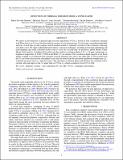Detection of thermal emission from a super-earth
Author(s)
Demory, Brice-Olivier; Gillon, M.; Seager, Sara; Deming, Drake; Jackson, Brian
DownloadSeager_Detection of thermal.pdf (2.788Mb)
PUBLISHER_POLICY
Publisher Policy
Article is made available in accordance with the publisher's policy and may be subject to US copyright law. Please refer to the publisher's site for terms of use.
Terms of use
Metadata
Show full item recordAbstract
We report on the detection of infrared light from the super-Earth 55 Cnc e, based on four occultations obtained with Warm Spitzer at 4.5 μm. Our data analysis consists of a two-part process. In a first step, we perform individual analyses of each data set and compare several baseline models to optimally account for the systematics affecting each light curve. We apply independent photometric correction techniques, including polynomial detrending and pixel mapping, that yield consistent results at the 1σ level. In a second step, we perform a global Markov Chain Monte Carlo analysis, including all four data sets that yield an occultation depth of 131 ± 28 ppm, translating to a brightness temperature of 2360 ± 300 K in the IRAC 4.5 μm channel. This occultation depth suggests a low Bond albedo coupled to an inefficient heat transport from the planetary day side to the night side, or else possibly that the 4.5 μm observations probe atmospheric layers that are hotter than the maximum equilibrium temperature (i.e., a thermal inversion layer or a deep hot layer). The measured occultation phase and duration are consistent with a circular orbit and improves the 3σ upper limit on 55 Cnc e's orbital eccentricity from 0.25 to 0.06.
Date issued
2012-05Department
Massachusetts Institute of Technology. Department of Aeronautics and Astronautics; Massachusetts Institute of Technology. Department of Earth, Atmospheric, and Planetary SciencesJournal
Astrophysical Journal. Letters
Publisher
Institute of Physics Publishing
Citation
Demory, Brice-Olivier et al. “DETECTION OF THERMAL EMISSION FROM A SUPER-EARTH.” The Astrophysical Journal 751.2 (2012): L28. Web. © 2012 IOP Publishing.
Version: Final published version
ISSN
2041-8205
2041-8213